Nowadays, tourism is one of the most profitable businesses in the world, using about 7 % of the world's capital, tourism is firmly took the third place after the export of petroleum, petroleum products and automo- biles. According to expert estimates, in 2005, tourism should be on the first place in this sector of the economy and every eighth person will be busy with tourism in the world.
According to the UN WTO data all international tourist arrivals recorded around the world reached an all-time record of 763 million in 2004.
T a b l e 1
World market shares of international tourism arrivals according to UN WTO world regions
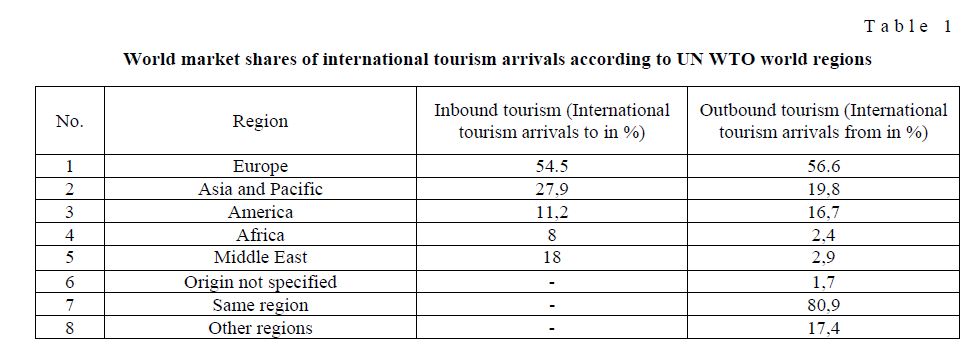
In relative terms, growth over 2003 corresponds to almost 11 %, a growth rate rarely seen in any other sector and the highest figure recorded since 1980. Growth was common to all regions, but was particularly strong in Asia and the Pacific (+28 %) and in the Middle East (+18 %). Double — digit growth was also reg- istered in America (+11 %). Africa (+8 %) and Europe (+5 %) performed below the world average, but built on positive results in the previous year, and still substantially improved their results. Even by sub — region all the results are positive. Further, UN WTO forecasts continuous growth in the future and predicts 1,600 million international tourist arrivals worldwide in 2010. The nations that do the most traveling (in terms of absolute spending) are Germany, the United State of America and the United Kingdom, followed by Japan, France, Italy, the Netherlands and Canada. More than 50 % of all international travel is directed to Europe and Europeans are, in terms of the UN WTO statistics, the population that does the most traveling worldwide.[1]
According to UN WTO estimates by 2010, a number of international tourist visits will be 937 million and income from tourism will increase 1.1 trillion dollars USA. In 2020, it is expected that travel to the famous cities in the popular resorts and monuments of history and culture make a 1.8 billion, revenue from hotel and tourism services would be approximately 2 trillion U.S. dollars. This means that there will be new jobs and millions of people get busy.
For example, only the Europeans in 2005, aged 15 and over, carried 370 million trips abroad, and 245 million trips (66 %) traveled on holidays and weekends, 88 million trips (24 %) attended friends or relatives and 37 million (10 %) made visits to business development.[2] For the growing number of Europeans traveling abroad had a positive impact on the following factors:
- a healthy economical situation in many countries;
- expansion of low-cost flight;
- good climatic conditions in the Alps;
Tourism is a non-productive sector, as well as the services were the main focus of exchange and ac- counted for 80 % of total sales at the various tourist markets.
Tourism is a huge source of foreign exchange means for the employment of the country. Every tourist entering the country creates an average of 9 jobs leaving the country of his residence about 1000 dollars for the trip.
Revenues derived from tourism businesses gain 32 branches of the economy. Figure 1 provides a list of the leading countries of the world's largest number of income derived from tourism.
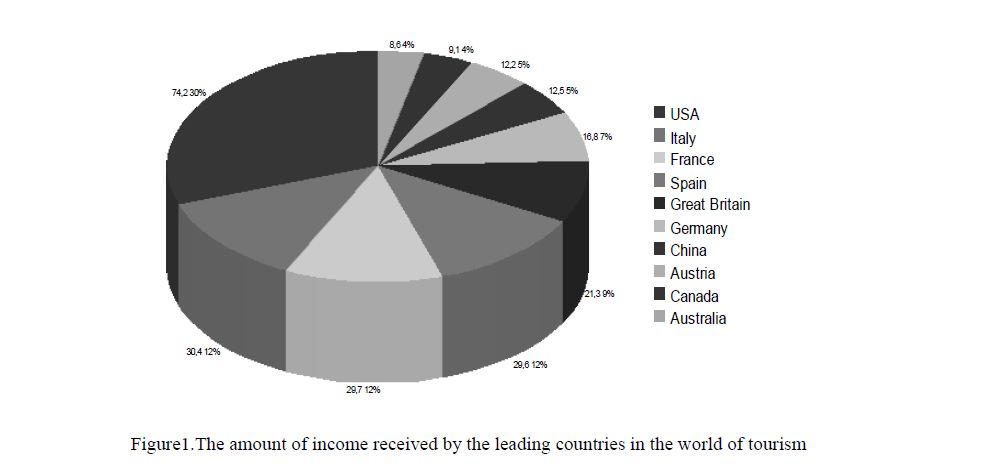
Figure1.The amount of income received by the leading countries in the world of tourism
Table 2 presents data, describing income from tourism, its share in GDP and the share of final con- sumption in the leading countries of the world.
The share of tourism in GDP and final consumption in the leading countries of the world
T a b l e 2

As can be seen from the data shown in the table, the largest share in GDP is tourism in Austria (8.5 %), the U.S. share of tourism accounts for only 1,0 %, while the highest income dollars worth in the first place.
Tourism is a major source of income for 38 % of the world countries, and also tourism is one of the five main sources of income for 83 %. In 2006, revenue from tourism throughout the world has increased in comparison with 2005 by 4,5 %.[3]
Tourism is not only the largest but also the most rapidly growing sector of the global economy. There are several enabling factors, including the following:
- firstly, the trip became an integral part of people’s lives;
- secondly, the cost of a trip around the world continues to
Potential dynamism of tourism development depends on a number of circumstances:
- firstly, tourism is an important factor in the growth of national wealth and improve the life of the nation as a whole;
- secondly, the most important areas of labor and factor of employment;
- thirdly, it’s really powerful stimulus for development of such industries as transportations, communications, construction, trade, agriculture, handicrafts, and production of consumer
As already mentioned, there is a prediction to create 550 million jobs by 2020 in the tourism sector. Table 2 presents data on employment in a number of industrialized countries in the accommodation and catering enterprises.
T a b l e 3
Employment in a number of industrialized countries in the accommodation and catering enterprises
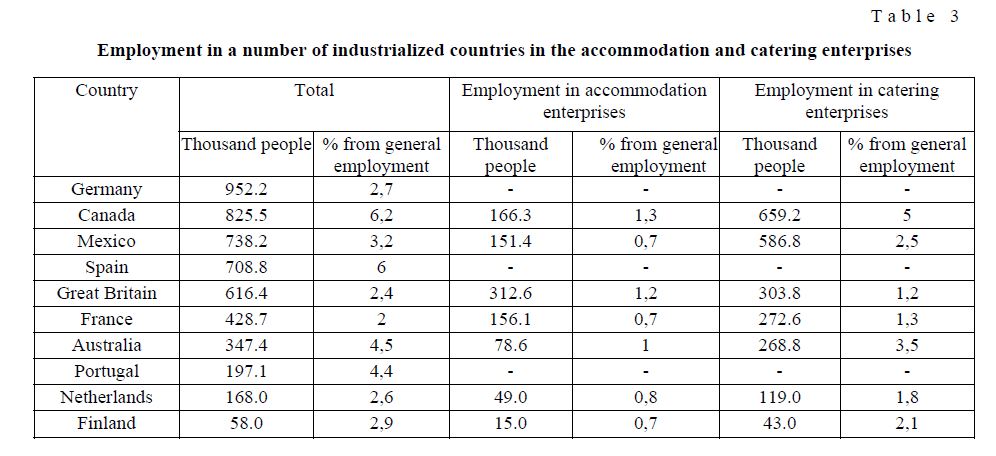
The growth of tourism must take place through the emergence of new visitors, as the traditional areas of the world’s tourist market have practically reached the limit of recreational vessels. So in recent years, business travel grew slightly, and in general reduced its market share.
The leading countries in the European market of tourist services in 2005 were Italy, France, Great Brit- ain, Norway, Spain, Denmark, Sweden and Finland. There are also the leaders or so-called «ripe markets», which include Italy, France, Great Britain. In future, positive trends will be continuing development of tourism in Spain, Croatia, Bulgaria, Tunisia and Morocco.
Ten countries — the leaders of outbound and inbound tourism in 2020 is presented in the table 3. However, despite the fairly high rate of development, tourism has not yet taken its rightful place in the theory of the national economy. Tourism is rarely seen as a science, and information on tourism has not yet been subjected to rigorous systemization. One of the most important factors influencing the development of tourism is the growth of incomes, which allows to spend more money on travel. Analysis of income tourists a number of European countries revealed that the tourist flow to the physical situation is dominated by middle-class.
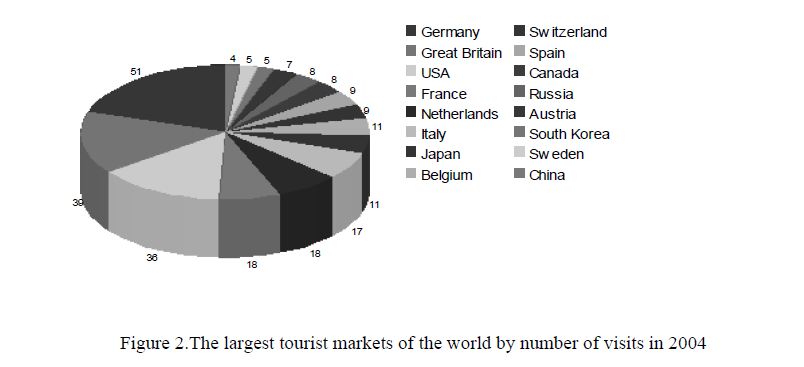
Figure 2.The largest tourist markets of the world by number of visits in 2004
Countries — leaders of outbound and inbound tourism in 2020
T a b l e 4
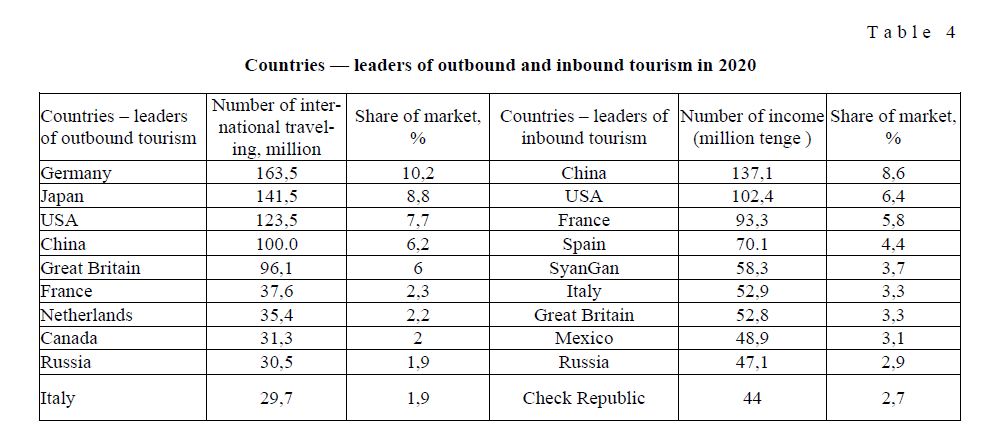
All countries in the world can be divided into the three groups by expenditure per capita. (Table 5)
Average annual expenditure of population on tourism per capita
T a b l e 5
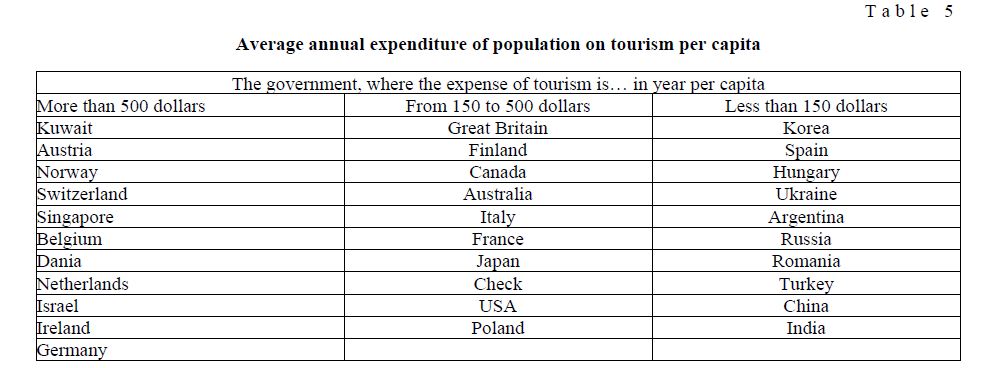
Cost-effectiveness of the tourism industry is the high degree of self-development as compared to other sectors of the economy. The highest rate achieved in 1993 when the number of trips has exceeded more than three billion. The tourism industry has a strong multiplier effect and has significant positive side effects than other economic sectors. Therefore, most of the countries have chosen tourism as a means to generate and accelerate economic development, improve the currency of the country, strengthening tourism infrastructure.
Over the past 30 years for the global tourism industry has been characterized by growth, twice the rate of growth of gross domestic product. Some developing countries have managed to increase exports of tourism services through the adoption of a clear policy aimed at the development of tourism, a significant investment in this sector and cooperation at the regional and sub regional levels.
The authors also made comparative analysis of sustainable policy in Kazakhstan and some developed countries.
It’s a well known fact that tourism industry is not so developed in Kazakhstan. That’s why the following 5 years we are going to develop tourism in our region taking account all points of sustainability. For achieving this we have already created the governmental program until 2011 year and considering to be the main tourist destination in the Central Asia. For understanding further about «sustainable» tourism, we took decision to make research and compare with countries such as Australia, New Zealand, Hungary and Portugal. (Table6) [4]
For instance, Australia has a highly developed tourism industry with a direct focus on sustainability. There appears to be a number of policies created by the government and tourism industry itself directed at maintaining the economic benefits of tourism, whilst taking great care of the environment.[5] Hungary represents a point of crossing between the various European cultures, thanks to its position in the center of Europe.[6] Hungary offers thermal spas, good wines, and a lively arts, cafe and music scene. In the countryside, travelers find majestic plains, Baroque towns, resort lined lake, horse markets and rustic villages, which are also under the protection.[7] A major draw-card to New Zealand would be its natural tourist attractions throughout the country. New Zealand has a relatively small population and therefore has an advantage in the preservation of the natural beauty. [8] (Table 7)
Tourism profiles:
Comparison of quantitative (absolute) data in year 2007
T a b l e 6
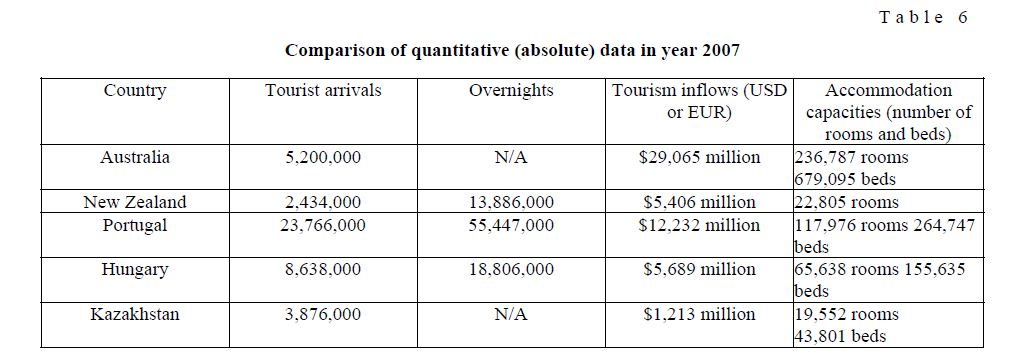
Comparison of quantitative (relative) data in year 2007
T a b l e 7

According to the results of research which were made by the government of Kazakhstan and American consulting services company «J.E Austin Associates Inc.», Kazakhstan has opportunities to develop the following competitive tourism products [9]:
- cultural-cognitive tourism (a lot of number of historical and archaeological monuments)
- ecological tourism (diversity type of landscape and distinctiveness of flora and fauna)
- business tourism (growing economic and the role of Kazakhstan in the Eurasia)
- sport and adventure tourism (good infrastructure of sport facilities and a lot of possibilities for the development of other types of sport).
Sustainable tourism is the part of tourism strategy of the Republic of Kazakhstan. According to strategic plan until 2011 the governmental program comprises all points of the concept of sustainability, such as:
- ecology: natural, social-cultural;
- economy;
- participation of all relevant stakeholders;
- high level of tourist
The first one is ecology: developing tourism in Kazakhstan is considering as one of the instruments for keeping historical and cultural heritages for the next generation. Right now, we have special program, which is called «Cultural heritage», whose responsibilities are protecting and keeping all the heritages on the terri- tory of Kazakhstan and out of them. All expenses run by foundation of government.
The second one is economy: Tourism is the most profitable structure of the world economy and Kazakhstan has already understood it. Well-known fact is the most share of GDP consists of raw materials and oil-gas, which considering as limited resources in the world. That’s why the development of tourism in our region gives us opportunities to make diversification in our economy, which means to develop no raw materials structure of our economy. Talking about participation of all relevant stakeholders we can say — in order to prove it will be «CLUSTER» policy in Kazakhstan and also every strategy is considering tourist satisfaction and their security abroad as well as Kazakhstan.
Australia already has highly developed tourism products. However, further attention is needed to be given to the sustainability of Australia's natural tourist attractions. The more that the natural attractions are protected the more economic benefits for the Australian economy there will be. Under the Tourism Australia Act (2004), Tourism Australia has a statutory obligation to help foster a sustainable tourism industry in Australia. The sustainable tourism policies are outlined in the White Paper of Australia, which is released every four years. It defines ‘Sustainable Tourism’ as the development of an internationally competitive, ecologically sustainable, and socially responsible tourism industry based on an integration of economic, social and environmental objectives, and constraints (White Paper, 2004, pg. 56).
New Zealand delivers a world-class visitor experience: In a competitive international environment, it is vital that we capitalise fully on the many wonders New Zealand has to offer. We must deliver products that are high quality, authentic, unique and delivered with superb service. New Zealand’s tourism sector is prosperous and attracts ongoing investment. The tourism sector and communities work together for mutual benefit: Tourism is a major economic contributor to many regions of the country. New Zealand tourism strategy is heavily impressed by sustainability, with the basic element of their tourism attraction — the na- ture — their strategy built up to protect environment for their future generation.
Portugal has to develop its four key differentiating elements (climate and light; history, culture and tradition; hospitality and concentrated diversity) and his qualifying elements (modern authenticity, safety and competitive quality). Portugal has got programs about recovering areas by cleaning them, protect areas and animal species from degrading, taxes and fees to those who don't respect the environment and material to educate people about tourism. And also tourism has been traditionally very important for Hungary, accounting for a high percentage of GDP throughout the review period. However, the share of national in- come realised from tourism has been steadily declining over the 2001–2006 period. This was due to an overall decline in incoming tourism expenditure, which the rapid increase in domestic spending could not entirely counterbalance. The trend, however, is expected to reverse during the forecast period, due to the growing importance of domestic tourism. The State Secretariat for Tourism has initiated the elaboration of a National Ecotourism Development Plan and a programme for supporting the establishment and enhancement of visitor centers at National Parks, protected areas and other ecotourism sites.
From our study of different countries and their different tourism industry and sustainability policies we have noticed a vast difference in each country. It would appear that Kazakhstan is moving in the right direction but still has a large area to improve. That’s why using foreign experiences, Kazakhstan has to develop tourism industry in sustainable way, if we want to leave something for the next generation and also to be profitable and environmentally friendlier. We have all opportunities to achieve our crucial vision to be «main destination in the Central Asia» and to be well-known as a «green» continent in our region.
References
- Mihalic Tourism and its environments: ecological, economic and political sustainability issues/ Tanja Mihalic -1.natis. — Ljubljana: Ekonomska Fakulteta, 2006. — (EF.Ucbenik) — 116 pages.
- https://www.cia.gov/library/publications/the-world-factbook/geos/nz.html
- http://www.nztourismstrategy.com/
- mts.gov.kz
- http://www.australia.com/
- http://en.wikipedia.org/wiki/Hungary
- http://www.planetware.com/top-tourist-attractions/hungary-h.htm
- http://www.world-tourism.org/sustainable/IYE-Main-Menu.htm
- kazakhstan-tourist.com